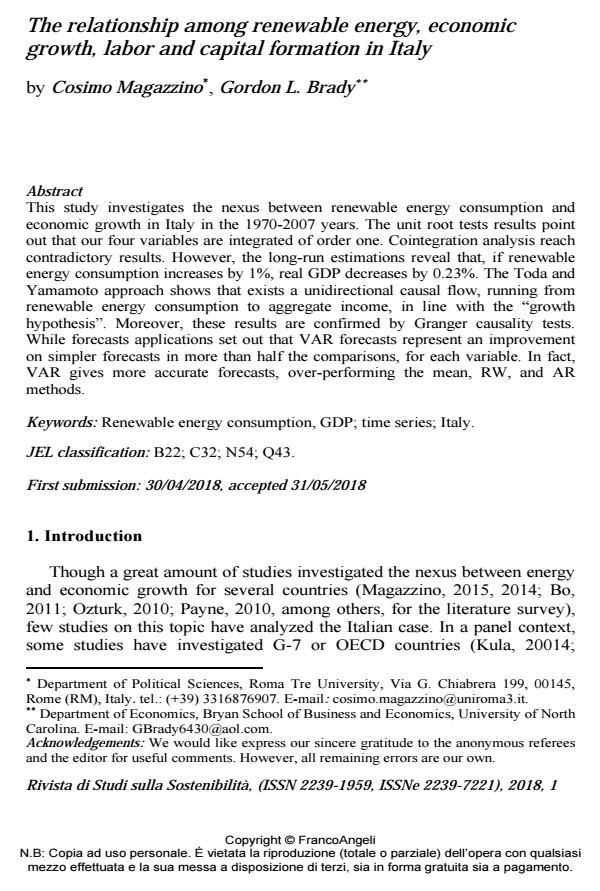The relationship among renewable energy, economic growth, labor and capital formation in Italy
Journal title RIVISTA DI STUDI SULLA SOSTENIBILITA'
Author/s Cosimo Magazzino, Gordon L. Brady
Publishing Year 2018 Issue 2018/1
Language English Pages 14 P. 35-48 File size 281 KB
DOI 10.3280/RISS2018-001005
DOI is like a bar code for intellectual property: to have more infomation
click here
Below, you can see the article first page
If you want to buy this article in PDF format, you can do it, following the instructions to buy download credits

FrancoAngeli is member of Publishers International Linking Association, Inc (PILA), a not-for-profit association which run the CrossRef service enabling links to and from online scholarly content.
This study investigates the nexus between renewable energy consumption and economic growth in Italy in the 1970-2007 years. The unit root tests results point out that our four variables are integrated of order one. Cointegration analysis reach contradictory results. However, the long-run estimations reveal that, if renewable energy consumption increases by 1%, real GDP decreases by 0.23%. The Toda and Yamamoto approach shows that exists a unidirectional causal flow, running from renewable energy consumption to aggregate income, in line with the "growth hypothesis". Moreover, these results are confirmed by Granger causality tests. While forecasts applications set out that VAR forecasts represent an improvement on simpler forecasts in more than half the comparisons, for each variable. In fact, VAR gives more accurate forecasts, over-performing the mean, RW, and AR methods.
Keywords: Renewable energy consumption, GDP; time series; Italy.
Jel codes: B22; C32; N54; Q43.
- Capitalizing on natural resources rent and renewable energy in enhancing economic growth—New evidence with MMQR method Musbau Omotola Kadir, Abraham Deka, Mehdi Seraj, Huseyin Ozdeser, in Natural Resources Forum /2025 pp.3421
DOI: 10.1111/1477-8947.12536 - Revisiting the dynamic interactions between economic growth and environmental pollution in Italy: evidence from a gradient descent algorithm Marco Mele, Cosimo Magazzino, Nicolas Schneider, Floriana Nicolai, in Environmental Science and Pollution Research /2021 pp.52188
DOI: 10.1007/s11356-021-14264-z - Insights of resources productivity and green technologies impact on renewable energy consumption: Novel MMQR approach Magdalena Radulescu, Abdulkadir Barut, Kamel Si Mohammed, Abdelmohsen A. Nassani, Ibrahim Cutcu, in Geological Journal /2024 pp.3033
DOI: 10.1002/gj.5044 - Economic Advancement and Renewable Energy Transition: Exploring the Integral Role of Trade Openness, Digital Transition, and Urbanization Among the NAFTA Economies John Wiredu, Qian Yang, Agyemang Kwasi Sampene, Shadi Saljoughipour, in Journal of the Knowledge Economy /2024 pp.15785
DOI: 10.1007/s13132-024-02564-x - Heterogeneous panel data model with sharp and smooth changes: Testing green growth hypothesis in G7 countries Hasraddin Guliyev, in Innovation and Green Development 100245/2025 pp.100245
DOI: 10.1016/j.igd.2025.100245 - The impact of energy consumption on economic growth: application of CES function for Romania Dorina Niță, Nadia Stoicuța, in Journal of Business Economics and Management /2025 pp.444
DOI: 10.3846/jbem.2025.23697 - Renewable energy and economic growth hypothesis: Evidence from N-11 countries Peijun Xie, Zili Zhu, Guangyun Hu, Jun Huang, in Economic Research-Ekonomska Istraživanja 2121741/2023
DOI: 10.1080/1331677X.2022.2121741 - How renewable energy and service growth influence environmental quality: Evidence from a sustainable development perspective Imen Chaouali, Mehdi Ben Jebli, Wadim Strielkowski, in Natural Resources Forum /2023 pp.257
DOI: 10.1111/1477-8947.12280 - The impact of energy efficiency in reducing environmental degradation: does renewable energy and forest resources matter? Abraham Deka, Suleiman Yakubu Bako, Huseyin Ozdeser, Mehdi Seraj, in Environmental Science and Pollution Research /2023 pp.86957
DOI: 10.1007/s11356-023-28434-8 - Renewable energy, economic growth and sustainable development: A model development in the light of empirical insights Narayan Parab, Ramashanti Naik, Y. V. Reddy, in Natural Resources Forum /2024 pp.572
DOI: 10.1111/1477-8947.12337 - Tiêu dùng năng lượng tái tạo, tham nhũng, và tăng trưởng kinh tế ở các quốc gia Châu Á Cảnh Lê Quang, in Tạp chí Kinh tế và Phát triển /2025 pp.74
DOI: 10.33301/JED.VI.2263 - Evaluating the disaggregated impact of renewable and non renewable electricity generation on economic welfare in India Khatib Ahmad Khan, Aqsa Anjum, Mohammad Subhan, Nurul Aishah Binti Khairuddin, in Scientific Reports 26725/2025
DOI: 10.1038/s41598-025-11316-z
Cosimo Magazzino, Gordon L. Brady, The relationship among renewable energy, economic growth, labor and capital formation in Italy in "RIVISTA DI STUDI SULLA SOSTENIBILITA'" 1/2018, pp 35-48, DOI: 10.3280/RISS2018-001005